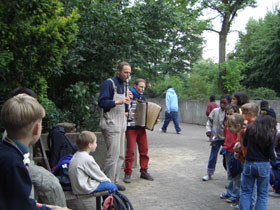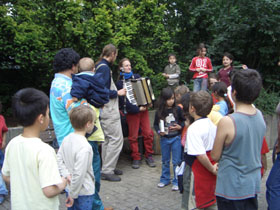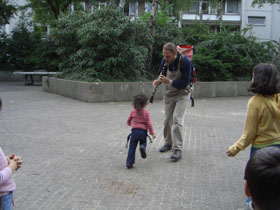
From space-structured residents to space-structuring residents
by Ulrich Doenitz
It is a sunny summer afternoon. The court of a high-rise building is quiet. Some children are hanging around. Others are passing through, obviously watching out for something to happen. A small group of adults are sitting in a corner as they would every afternoon, waiting for something to happen, for a job, waiting for a miracle, waiting for a change in their lives. They were waiting as they did every afternoon. However, this afternoon was going to be different. Two strangers appeared carrying luggage. They had never been here before. What was going to happen? The two sit down in another corner of the court and start to unpack their luggage. Within a few moments an accordion and a clarinet fill in the court with music and the two musicians attract the attention of the children. Gathering together the small listeners start asking questions and suggesting their favourites for the next song to play. They start singing along. The scenery of the court seemed to have changed from being silent, boring and depressive to music, excitement and action. Finally two young girls fetch their flutes and start giving a concert of their own. The court changes into a stage of the performing artists.
Research into neighbourhood development concluded that some residents are structured by space: they have time in abundance, they are present in public space, they do not need to make dates to meet their friends because they know the places nearby where they would be (examples: children, youth), but: they rarely gain influence on space-structuring processes of urban planning. They are structured, shaped by the environment they grow up and live in. Other residents and professionals are structured by time: they are rarely present in the streets because their car takes them from one date to another, often they do not even know the names of their neighbours. Planning professionals and forums of negotiation mostly are structured by time. They do not get visible in public space but take place inside public buildings behind doors, which exclude space-structured residents from forums of consultation and decision-making.
Space-structured residents, however, have lots of ideas on what their urban environment should look like. Due to their presence in the streets, they have a detailed knowledge on what takes place. However, they do not come to notice planning decisions unless they get visible in the places where they themselves are present. Yet normally such decisions are taken years before they get visible in their spatial consequences. Once space-structured residents get to know about what is happening, it is too late to take influence. The potential space-structured residents have to contribute to spatial development does not get visible.
Reflecting upon the
Camp for Oppositional Architecture, upon the results of neighbourhood
governance research and upon our experience as street musicians made us start
a series of urban interventions in the Ruhr area throughout the summer 2004.
The idea was to create access to urban development for space-structured residents.
The approach was not to take residents into time-structured long-term processes
of negotiation on urban development, but to start structuring space through
action interpreting physical structures as a stage with the potential for
a wide range of actions.
However simple and temporary the above experiment seems to be, it reveals
the power residents can have to reinterpret their environment. It is obvious
that this magic power normally does not become visible. And even our example
was a temporary experience of one afternoon. As the Camp for Oppositional
Architecture could show, a considerable number of professionals deal with
interventions in urban contexts around the world.
(click here for The Interventionist Manuel by Ulrich Doenitz)
Ulrich Doenitz:
Since 1996
Freelancer at the „Planungsbüro Stadt-Kinder“ (planning partipation
consultant) developing new concepts to participation of youth in processes
of urban development, combining traditional methods of planning and methods
like theatre pedagogy and outward bound to come to new ways of both designing
urban spaces and intervening into planning processes at urban and regional
levels.
Since 2001
Part-time employee within the Research Institute for Regional and Urban Development,
Building and Construction of the Federal State of North Rhine-Westphalia.
Since 2003
Starting to link street music and street action to processes of urban planning,
taking music into the streets at uncommon times and places with the ensemble
“Die Murmeln” (together with Micha Fedrowitz/accordion). First
tour of urban music with the ensemble in 2004.
2005
Taking the new approach to the British Isles, starting as a street musician
in Cardiff



